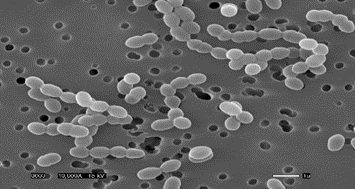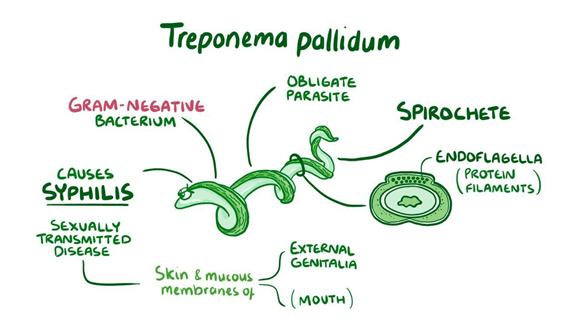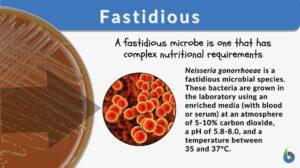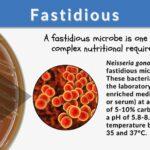
Fastidious
adj., [fæˈstɪdi.əs]
Definition: (of microorganisms) having unusual and/or complex nutritional needs and must be grown on enriched media
Table of Contents
Fastidious Definition
We can define fastidious as a term used in microbiology to denote a species that lacks the ability to grow in any culture but a culture with special nutritional requirements. Fastidious bacteria are not always easy to grow in culture and may not be easily obtained from a sample. This is problematic in the laboratory, where a specific culture medium is required for growth, and growth media are expensive to purchase and maintain. The term ‘fastidious” in this sense seems imprecise as these fastidious organisms are found in nature or the environment. Nevertheless, the term is used in the context of the lack of growth of a bacteria in a particular culture without a sufficient amount of essential nutrients for the bacterium to proliferate.
What is fastidious nature?
The fastidious nature of a bacterium means that it cannot grow in standard laboratory media. However, it can grow in a particular culture medium composed of a particular nutrient and a particular buffering agent. Fastidious bacteria, therefore, are bacteria that generally cannot grow using the standard laboratory media. For example, if you have a bacterium that is fastidious, then it is not likely to grow in a particular medium. An overly fastidious microorganism would even require additional growth conditions, such as allowing it to grow in a cool, dark place, and other factors such as a specific range of temperature, oxygen, carbon dioxide, and pressure.

Etymology: fastidious, from Latin “fastīdiōsus”, “fastīdium” meaning “niceness of taste”, etc.
Fastidious Synonyms (general): There are many synonyms used for fastidious in the general sense, i.e. demanding, particular, careful, excessively concerned, perfectionist, careful attention, meticulous, attention to detail, fussy, choosy, discriminating, cautiously, captious, critical, exacting, precisely, critically, thoroughly, scrupulously, in detail, punctiliously, concernedly, prudently, laboriously, finicky, honorably, delicate, sedulous, cleanly, and reliably.
Derived forms: fastidiously (adverb); fastidiousness (noun)
Fastidious Bacteria
Fastidious bacteria are microorganisms that are difficult to cultivate in the lab due to their complex or limited nutritional and/or environmental requirements. Furthermore, a fastidious bacterium will only survive in the presence of specified nutrients in the culture medium. These bacteria can cause serious infections, and so in many situations, early discovery and monitoring are important (Mobed et al., 2019). Anaerobes like Bacteroides fragilis are examples of fastidious bacteria. They can be difficult to culture in the lab and can make establishing antibiotic sensitivity challenging.
Characteristics of Microbial Fastidiousness
The three basic properties of microbial fastidiousness (i.e., complicated and particular dietary requirements):
- Ecologically limited
- Fastidiousness is positively associated with smaller genomes and metabolic networks
- More fastidious species grow more slowly and have less ability to interact with other species than more metabolically versatile organisms (Zarecki et al., 2014). These properties indicate that fastidious microbes have adapted to habitats with few cohabitating species. To study them, we have to grow them successively.
What does fastidious mean in microbiology? Microorganisms that will only develop if specific nutrients are present in their culture medium are referred to as fastidious microorganisms in microbiology (Sridhar Rao, 2012). These microorganisms must be inoculated and cultivated in a medium that contains all growth requirements, including water and nutrients, to ensure successful growth. In addition, the pH and temperature of the cellular environment must be properly regulated and maintained.
Thus, the common characteristics of fastidious bacteria are first, the need for reliable culture media and second, exposing them to certain environmental conditions, such as specific temperatures, nutrients, osmotic conditions, and many more.
Interesting Fact:
Why did the most fastidious organism grow poorly? Fastidious organisms require growth-supporting chemicals, enrichments, vitamins, or blood, which are not present in chemically defined media, that why they grow poorly (Zarecki et al., 2014). They are choosy in nature and require special nutrients for growth. For instance, Lactobacillus grows best in cheese but poorly in milk (Ibrahim, 2016). B. subtilis seems to be the most fastidious, as it grew the least in all culture media.
Fastidious Examples
A fastidious organism is an organism with complex or complicated nutritional requirements. On agar plates, these organisms normally grow and multiply slowly, demanding a lot of food supplementation and environmental control. Leuconostoc mesenteroides, for example, is a facultative anaerobe that requires many growth hormones and amino acids to grow. Fastidious creatures come in a variety of shapes and sizes, each with its own set of requirements for survival (Simmons, 2019).

Another fastidious microorganism is Lactobacillus. Lactobacilli are fastidious microorganisms that require an exogenous nitrogen supply like amino acids or better peptides to develop. Casein, the most abundant protein in milk, is processed through proteolysis to produce these nitrogen sources (Ibrahim, 2016). Lactobacilli have a variety of impacts on dairy products including fermented milk and cheeses, depending on the species, strain, manufacturing conditions, and product. They are known as “good bacteria” as they can be used to treat diarrhea and improve “gut health”.
Fastidious organisms are not intrinsically “weak”; they can thrive in their specific ecological niche, with their particular nutrition, temperature, and lack of competition, and they can be extremely difficult to eradicate. However, they are challenging to culture simply because accurately simulating their natural environment in a culture media is difficult (Sridhar Rao, 2012). These organisms are excessively fastidious eaters in nature. Treponema pallidum, for example, is difficult to culture but resilient in its natural environment, making it difficult to remove from all tissues of a syphilis patient.

Watch this vid for more examples of fastidious organisms:
Fastidious vs. Non-fastidious Bacteria
Bacteria that relatively do not require special culture media to grow are described as non-fastidious. Below is a table for more examples of fastidious and non-fastidious bacteria.
Table: Fastidious and Non-Fastidious Bacteria | |
|---|---|
| Fastidious bacteria | Non-fastidious bacteria |
| Neisseria gonorrhoeae Causative agent of gonorrhea in humans Special requirements: enriched media in a humid environment at 35-37°C in 3%–5% CO2 a CO2 | Escherichia coli (normal flora in the human gut) |
| Francisella tularensis Causative agent of tularemia Special requirements: Traditionally, cysteine glucose blood agar but now, enriched chocolate agar (cysteine heart agar supplemented with 9% heated sheep red blood cells [CHAB]) and nonselective buffered charcoal yeast extract agar may be used, at 37°C. | Vibrio natriegens (ultrafast-growing marine bacterium and non-pathogenic to humans) |
| Borrelia burgdorferi Causative agent of Lyme disease Special requirements: modified Barbour-Stonner-Kelly (BSK-H) medium at 35°C | Clostridium perfringens (Common agent of foodborne diseases in humans) |
| Legionella pneumophila Causative agent of pneumonia Special requirements: buffered charcoal yeast extract (BCYE) agar in a humid environment at 35°C in 3%–5% CO2 | Bacillus subtilis (free-living in soil; normal flora in the human gut) |
Answer the quiz below to check what you have learned so far about fastidious organisms.
References
- Merriam-webster. (2022). On-line at http://www. mw. com/home. htm, 14.
- Ibrahim, S. A. (2016). Lactic Acid Bacteria: Lactobacillus spp.: Other Species. https://www.sciencedirect.com/topics/agricultural-and-biological sciences/lactobacillus
- Mobed, A., Baradaran, B., de la Guardia, M., Agazadeh, M., Hasanzadeh, M., Rezaee, M. A., … & Hamblin, M. R. (2019). Advances in detection of fastidious bacteria: From microscopic observation to molecular biosensors. TrAC Trends in Analytical Chemistry, 113, 157-171.
- Simmons, H. (2019, Jan 25). Growing Fastidious Microorganisms in the Laboratory. News Medical Life Sciences. https://www.news-medical.net/life-sciences/Growing-Fastidious-Microorganisms-in-the-Laboratory.aspx
- Simpson, J. A., Weiner, E. S. C., & Oxford University Press. (1989). The Oxford English Dictionary. Oxford: Clarendon Press.
- Sridhar Rao, P. N. (2012). Bacterial culture media. Retrived from https://www.microrao.com/micronotes/pg/culture_media.pdf
- Zarecki, R., Oberhardt, M. A., Reshef, L., Gophna, U., & Ruppin, E. (2014). A novel nutritional predictor links microbial fastidiousness with lowered ubiquity, growth rate, and cooperativeness. PLoS Computational Biology, 10(7), e1003726.
©BiologyOnline.com. Content provided and moderated by Biology Online Editors.








